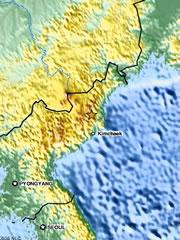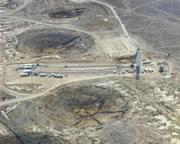What has happened?
 The seismic rumble was detected near Kimchaek.USGS
The seismic rumble was detected near Kimchaek.USGSOn Monday morning, North Korea announced it had performed an underground test of a nuclear bomb, apparently warning China about 20 minutes beforehand. North Korea has been asked to step back from nuclear ambitions; the news of this first test has brought widespread international condemnation.
An official North Korean government statement said: "It has been confirmed that there was no such danger from radioactive emission in the course of the nuclear test, as it was carried out under scientific consideration and careful calculation. The nuclear test was conducted with indigenous wisdom and technology, 100 percent." But international observers say there are signs that the test may not have gone perfectly.
Was the blast detected?
The South Korean Institute of Geoscience and Mineral Resources reported that at 10:35:27 AM, local time on 9 October 2006, a seismic tremor measuring 3.58 to 3.7 on the Richter scale was detected. The US Geological Survey later announced that they recorded seismic activity rating at 4.2 on the Richter scale.
Does that confirm the North Korean claims?
 The seismic trace recorded at Inchon, South Korea, on Monday morning.USGS Live Internet Seismic Server
The seismic trace recorded at Inchon, South Korea, on Monday morning.USGS Live Internet Seismic ServerProbably, but not in isolation. It is easy to say that the blast was an explosion rather than an earthquake by looking at the seismic signal: an explosion has a much sharper start than a quake. But to identify the details of a nuclear explosion will take more delving. Scientists will pour over seismic data in the coming days. To get a complete picture, the geology of the rock will also need to be considered.
Radionuclide analysis of particles leaked into the atmosphere by the blast can also give evidence of a nuclear explosion. But again these data need to be collected and analysed, which should take 2 or 3 days.
International networks of seismology and radionuclide stations exist to do this kind of testing and verification.
Satellite images of any subsidence craters may also help confirm the underground test.
How big was the blast?
 The Nevada nuclear test site in the United States shows craters from previous underground explosions.US Department of Energy
The Nevada nuclear test site in the United States shows craters from previous underground explosions.US Department of EnergyEstimates for the bomb's yield (the amount of energy discharged when the weapon is detonated, in the equivalent mass of trinitrotoluene, or TNT) differ widely, from 550 tons of TNT to 5-15 kilotons (this last a Russian estimate). By comparison, the Hiroshima bomb was about 12.5 kilotons.
The lower estimate is very small: it would be difficult to build a bomb with a critical mass of plutonium that creates a blast like this. It may be that the bomb didn't completely detonate, or that the chain reaction didn't go to completion.
Does anyone know what kind of bomb it was?
Most likely plutonium, although North Korea has been under suspicion for having a uranium enrichment programme. North Korea is estimated to have between 7 and 24 kilograms of plutonium, which depending on how much is needed for a bomb (4 to 8 kilograms) could produce only just enough for one bomb or up to four.
To create a blast this size without a nuclear reaction, a huge amount of TNT would be needed — and a very large underground hole would have to be excavated, which would be easily spotted by spy cameras.
Could North Korea launch a nuclear attack?
ADVERTISEMENT
Rumours are rife that an arms race will ensue. Japan, China and South Korea are under close scrutiny. As far as North Korea's progress goes, they tested a missile in July this year, which exploded on take off. The worry is now that North Korea could piggyback a nuclear device onto a missile. This would require a small and light nuclear device, and miniaturizing nuclear fission is a very technical domain. How far North Korea is in succeeding, only they know.
Visit our koreanblastseemssmall.html">newsblog to read and post comments about this story.
